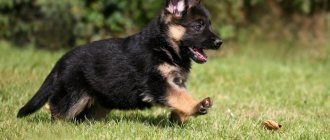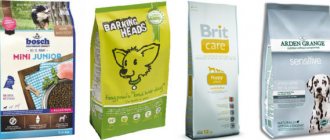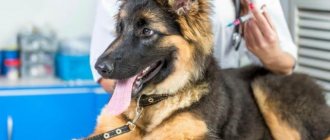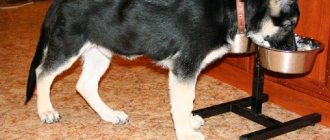The health of a German Shepherd is directly related to how healthy the diet is.
An ill-considered diet not only worsens the dog’s appearance, but also leads to irreversible deformations of the skeleton and joints. The first 1.5 years are especially critical, when the puppy is actively growing and gaining weight.
Fully feeding little “Germans” is a troublesome and time-consuming task. Making a menu in a hurry after the pet arrives in the house is not the best option. It is worth finding out in advance how and what to feed your German Shepherd puppy.
Feeding a German Shepherd puppy at 1 month: workdays have begun
Nowadays, in almost all localities you can find ready-made food for pets. These mixtures are divided into several classes, and the higher the quality of the food, the higher the cost. We suggest you follow the “old fashioned” route: feed your dog only natural food. This is meat and porridge. This method can be called more acceptable if the diet is varied and the baby receives all the microelements necessary for health. You need to remember the only rule: cheap products cannot be good and healthy.
Cheap products do not mean good!
Even before you take the puppy from its home, the owners begin to introduce complementary foods. Ask the owners what the kids are given, and then you will roughly know what quality your future guard will be.
Typically, the diet of a German Shepherd puppy up to 1 month old includes:
- Raw minced or finely chopped meat
- Dairy
- Fine cereals
That is, in fact, the puppy must be able to eat everything and, moreover, willingly accept the food offered.
Our goal is to get a beautiful, powerful and efficient dog. According to statistics, by the age of two years the weight of German Shepherds is distributed as follows:
- Males - 32-40 kg
- Females – 22-32 kg
Of course, these figures are very average and some specimens reach much greater weight. But not due to fat, but because of genetic characteristics.
A beautiful and healthy German Shepherd is a reflection of the owner’s care
So, how to feed a 1 month old German Shepherd puppy? First of all, you need to pay attention that at this age the growth rate of Germans is simply enormous, and all because of their increased metabolism. But the size of the stomach is quite small. Therefore, in the first month it is better to feed the baby high-calorie foods that are quickly digested. In this case, portions should correspond to the size of the stomach, that is, be small. And the total volume eaten should be approximately one glass.
A one-month-old puppy is cute and not at all scary
The diet of a one-month-old German Shepherd puppy should include the following foods:
- Meat. Both raw and cooked. And it must be beef. Raw meat is either scraped off or cut into small pieces and given to the puppy during feeding “for dessert”. It is raw meat that stimulates the growth and normal development of the body. But you shouldn’t give minced meat. The puppy must learn to chew the fibers on its own. Boiled meat can be given along with porridge cooked in the same broth.
- Milk. This is not only milk in liquid form, but also porridge cooked with it. Rice and oatmeal are great. All this needs to be ground thoroughly. You should also give cottage cheese mixed with raw yolk or kefir.
By the way, about microelements. It would be useful for absolutely all owners to learn about such a disease as rickets. The disease develops when nutritional standards are violated, and more specifically, when there is a lack of elements containing calcium. The initial stage of rickets manifests itself in the puppy’s nervous system. He becomes overly timid, hides from the light and reacts painfully to sharp sounds.
This is what rickets threatens any dog with
Subsequently, changes occur in the structure of bone tissue. A sagging back and curvature of the paws are all rickets. Moreover, the bones of the entire skeleton are deformed. At this time, the transformation of cartilage tissue into bone tissue occurs, and when microelements are washed out, such things happen.
And with a lack of sunlight, characteristic “bracelets” appear on the joints, and “rosaries” appear on the ribs. These defects cannot be corrected.
In the first year of life, you need to pay close attention to nutrition. The slightest deviation from the ideal diet can provoke, for example, the appearance of many deficiencies, after which it will be impossible to classify the dog as purebred.
To avoid all these misfortunes, be responsible: feed your puppy nutritious food and take him for walks more often. Approach feeding your one-month-old German Shepherd puppy from the point of view of a professional breeder, and everything will be fine.
Basics of proper care
You need to start caring for your dog from your first day together. You should immediately prohibit doing something that, in your opinion, is not advisable to do. For example, lie down on a bed or sofa. It is necessary to isolate from the animal all things that it can chew. Remove the wires, close the doors to those rooms into which your baby should not poke his curious nose. Caring for a pet includes not only continuous attention, but also compliance with certain conditions for its normal existence in each year of its life.
Caring for and maintaining your pet includes the following basic points:
- habitat;
- walks;
- hygiene.
Content area
The most suitable place for a dog like a German Shepherd to live is undoubtedly a street where the baby can have plenty of fun in the fresh air. A private house is best suited for this purpose. For comfort, it is worth building a strong enclosure with a wooden floor, a roof and a comfortable booth. All this will reliably protect the German from climatic conditions. If you live in an apartment, then, naturally, you can take excellent care of your pet there, too, by creating a wonderful place.
It should not be located in a passage where a draft is possible, near doors and heating appliances. The dog should not sleep in the bathroom or kitchen either. Having chosen a decent corner, you need to lay a special rug or mattress there, which, ideally, is best covered with a pillowcase. This is very convenient for keeping the sleeping area clean. Prepare several pillowcases so you can change and wash them on time.
Prepare for the fact that at first your beloved baby will do his dirty deeds at home, because he still can’t stand it. Gradually, it is necessary to teach him to relieve himself while walking, immediately after feeding or sleeping. Always reward your dog with a tasty bite of his favorite treat as soon as he does the wet thing. Thanks to your efforts, by six months the shepherd will learn to relieve itself only in the yard.
During the first days, the puppy may whine loudly, missing his mother and his former home. Therefore, you should not leave him in a dark enclosed area or tie him up. Try to calm him down with gentle words, give him a toy. But it will be unnecessary to constantly stroke or squeeze the baby: this risks instilling unnecessary qualities.
Going outside
The Shepherd simply needs stable long walks. You can start walking your pet only after all vaccinations have been completed. As mentioned above, the best option for a dog is to live on the street, where there is a constant opportunity to run freely in the open air. If this option is not available and you live in an apartment, then you need to take your pet for a walk every day, gradually increasing the walking time. It's best to take walks during the daytime to take advantage of the sun's natural ultraviolet rays.
The first walks should be short, five minutes will be enough. At the age of two months, hikes increase to half an hour, while at 6–10 months it is necessary to spend two to three hours walking. From two months you can accustom your dog to a leash. While the baby is small, physical activity is contraindicated for him; as he runs around, it will immediately become clear that it is time to go home. When your pet gets older, it will be very good for psychological development if he interacts with other purebred dogs in specially designated areas. But you shouldn’t let stray dogs near them - the risk of disease is high.
Now let's look at German Shepherd hygiene.
Animal hygiene
The eyes are clean, without discharge, with a clear gaze. You need to worry when your dog experiences inflammation or redness, or unnatural watery eyes; if he blinks frequently. If these symptoms occur, you should immediately contact your veterinarian or use special eye drops. You can also soak a cotton swab in chamomile infusion and rinse your eyes with it.
Teeth should be brushed once every three months with a special tooth powder. In pet stores you can also purchase special fluoride-based bones. Also suitable for this purpose are artificial bones made of leather, which will cope with cleaning fangs and massage your pet’s jaw.
Ears are cleaned once a month. This can be done either with a tampon or with special-purpose means. Be careful when observing your baby's ears. They contain a small amount of odorless sulfur. If redness, wet discharge are visible, a bad odor is felt; A pet scratches its ear and shakes its head, which means inflammation is occurring. Don't hesitate and consult a doctor.
The coat should be combed once a week with a special comb. We recommend washing your dog three times a year, except in winter, using specialized dog hygiene products. After each walk, wash your pet with plain water; if there is no special contamination, wash only the paws. After the bath, dry the animal's fur thoroughly. After a bath, try to protect your dog from drafts.
Healthy claws do not peel, do not crumble, and are dark in color. If the baby has not sharpened them himself, then they need to be trimmed with special guillotine scissors.
Now let’s take a closer look at what to feed a purebred German Shepherd puppy.
Nutrition for a German Shepherd puppy at 2-3 months
Starting from the age of two months, the diet of a German Shepherd puppy should include plant fiber. The simplest option is boiled and grated carrots, which are added to the porridge. Mixing in unrefined vegetable oil will be very useful and necessary. Pharmacy pumpkin is better, but sunflower is also possible. Dose - a teaspoon per day.
In the summer, you can feed with any seasonal vegetables and fruits.
At this same time, many breeders offer the puppy a sugar bone. By about 3-3.5 months, the baby’s baby teeth begin to fall out and permanent teeth begin to erupt. The age given may vary, but nevertheless, your puppy will chew everything that comes his way. Therefore, the option with marrow bone looks very tempting. To prevent the pungent smell from causing inconvenience, you can simply boil the bone.
As for how to feed a 2-month-old shepherd puppy, it’s basically clear. Meals can be reduced to four times. And the daily volume of food eaten should be equal to one and a half glasses.
We have figured out what to feed a two-month-old German Shepherd puppy and move on to the next point.
Answer
The German Shepherd is a breed focused on serving people. She will be an obedient, devoted friend for life if properly cared for and raised. One of the main conditions for a long and healthy life for a pet to the delight of its owners is proper, nutritious nutrition. Moreover, it is important to clearly monitor this, starting from an early age, when the young body is growing and forming.
Feeding a German Shepherd puppy at 4 months
A German puppy at 4 months is already a fully grown dog. It is at this age that breeders reconsider the diet of their charges. What does a German Shepherd puppy eat at this age?
Firstly, the animal continues to change its teeth and at the same time its ears become larger. You need to increase the dose of calcium and collagen, otherwise the ears may not stand up as they should. There is enough of this goodness in broths made from hooves, chicken paws and wings, heads and tails. You can also purchase various medications at the pharmacy. Regular gelatin will also work. A spoonful of the product is soaked and added to the porridge.
During this time, the German Shepherd puppy's diet does not change much. Let your pet continue to chew on the bone and he can be given a potassium complex vitamin. But the volume of food should increase slightly. That's about two glasses of food.
Bone is a favorite treat
And by the way, do you know why some Germans have bright red tan, while others have light straw? During puppyhood, the color of the coat begins to form, and to make it brighter, you need to include in the diet of your German Shepherd puppy:
- Raw grated carrots
- Turmeric
- Sea kale
- Beetroot
Beautiful rich color of the German Shepherd
Breed characteristics
Breed characteristics leave an imprint on raising puppies. The type of food depends on the size of the dog, its working qualities and many other aspects of physiology, purpose and lifestyle.
All dogs are genetically carnivores, but an active life and constant movement requires compensation for energy costs in the form of high-protein diets. Puppies grow disproportionately, and often the rapidly increasing body weight “puts pressure” on the fragile skeleton, as a result of which puppies begin to have problems with the musculoskeletal system.
Remember! It is not difficult to spoil a dog by turning it into a disabled person: physical activity that is inappropriate for its age and an unbalanced diet will quickly do their job.
Any type of nutrition requires a regimen, a competent approach to diet planning, and careful attention to your pet.
Feeding a 5 month old German Shepherd puppy
At this age, your German Shepherd puppy's diet needs to change slightly. By-products are introduced into the diet:
- liver (boiled)
- lungs
- udder
- brain
- hearts
- stomachs
- spleen
German Shepherd puppies at five months
The weight of food eaten at one time can reach 400 grams. Cottage cheese is being gradually removed from the menu, and male dogs are not given milk at all.
New types of food are introduced for the puppy:
- Porridge: wheat, buckwheat
- Poultry: raw and cooked
- Eggs: boiled
Remember that the best food for German Shepherd puppies is a thoughtful mix of vegetables, meats, oils and vitamins.
What to choose - dry food or natural food
Many dog breeders choose industrial food for their German Shepherd, since it contains the necessary complex of microelements, vitamins, vegetables and meat. Ready-made granules are easy to use: there is no need to develop a diet; the serving size for any age is indicated on the product packaging. When choosing natural food, you can be confident in the freshness and quality of the products, and create a varied menu for your puppy, based on his taste and preferences.
Feeding a German Shepherd puppy up to one year old
The nutrition of a young dog at this time does not change much . After 6 months, the puppy eats everything the same as before, only the portion sizes increase. The bone can now be removed, since the dog has acquired strong teeth with which it can chew it. If shrapnel gets into the esophagus, it can cause injury such as perforation, so it’s better not to risk it.
Almost an adult German Shepherd
The diet of a German Shepherd up to a year is already similar to the diet of an adult dog.
How much food should I give my kitten?
The dosage of dry food depends on its quality. Super-premium products contain all the necessary elements, which allows them to surpass natural food in nutritional value. It is economical, the portions are small, the size depends on the purpose of raising the German Shepherd, the weight of the parents and the intensity of the pet’s development.
You can find out how much dry food you should give your puppy at different ages from the table:
| Age in months | Puppy weight | Feed quantity |
| 2 | 7.6 kg | 240 g |
| 4 | 13.5 kg | 310 g |
| 6 | 18 kg | 350 g |
| 8 | 26 kg | 428 g |
| 10 | 35 kg | 432 g |
How to feed a German Shepherd puppy after a year
After a year, your cute puppy will turn into an adult, albeit very young, German Shepherd.
German Shepherd at one and a half years old
The ratio of foods in the diet:
- Meat - 30-50%
- Porridge - 25-35%
- Vegetables - 5-20%
Fresh vegetables are preferable to boiled ones, and if you feed raw meat, deworm them regularly. Crackers and fruits are suitable as treats. Don’t give tubular and sugar bones at all, they have no benefit but are a constant threat. In addition, bones can cause constipation. It is advisable to give fish, especially river fish, as rarely as possible, since there is practically nothing useful in it for your friend.
Feeding a German Shepherd puppy with natural food after a year will take quite a lot of your time, money and effort, but all these troubles will pale in comparison to the realization that now you have a real friend with you!
Basic Rules
Experienced breeders adhere to the following rules when feeding the offspring of German Shepherds:
- The puppy is given food at room temperature or a little warmer. You can test this by placing your finger in the center of a bowl of food.
- After finishing the meal, wipe the baby’s face with a napkin to remove any remaining food.
- Having drawn up a feeding schedule, you need to stick to it, otherwise the dog may have problems sleeping and development will worsen.
- During the first months, it is recommended to be close to the puppy during feeding, teaching him the correct stance, observing his position in order to correctly adjust the height of the bowl.
- The thickness of the food should resemble the consistency of sour cream.
- By adhering to the requirements of food hygiene - giving food to the dog one and a half to two hours after an active walk, giving it a rest after eating for 2-3 hours, you will be able to avoid digestive disorders.
- After 20 minutes, the bowl with uneaten food is removed, this will prevent satiety with food and overeating.
And a little about products for dogs
In order for your pet to be healthy, beautiful and feel great, you need to balance its diet so that the growing body receives everything it needs. It's no secret that a dog is a predator, although to a lesser extent than a cat. Therefore, for a dog, the main source of energy and everything else is proteins. And only then come fats, carbohydrates, minerals, fiber and vitamins.
Proteins for a puppy
The main source is animal products, that is, meat. It can be given either raw or boiled. Still, give preference to raw, as it provides everything your puppy needs.
The baby will happily scratch his gums on the sugar bone, but at an older age the bones are already dangerous - they can injure the intestines and stomach.
As for fish, in principle you can treat your dog to it a couple of times a week, but only sea fish - raw or boiled, without bones. Fish products wash out vitamin B, resulting in intestinal upset, growth retardation, dandruff, and weakening of the name system. Finally, fish tend to accumulate heavy metals, which will cause banal poisoning.
Cottage cheese is an excellent source of protein, but raw eggs are poorly digestible. Moreover, raw protein can cause dermatitis. Therefore, if there are eggs, then boiled or in the form of an omelet. Milk, kefir, yogurt, etc. you can and should give. They are offered either raw or cooked as milk porridge.
Fats for dogs
This is also an important element. Moreover, the German Shepherd needs both animal and vegetable and milk fats. A sign that the animal has enough of everything is smooth, shiny fur.
A baby needs 2.6 grams of fat per 1 kg of weight per day. Add animal fats to soups and cereals. Sometimes it can be replaced with butter. The dose for a puppy up to 3 months will be 10-15 g, for a six-month-old puppy - 20-25 g per day.
And vegetable fats contain valuable unsaturated acids. They increase the puppy’s resistance to various diseases, stimulate rapid growth, normalize metabolism and have a positive effect on the circulatory system.
Carbohydrates
This is an important component that provides energy and stimulates the gastrointestinal tract. These are starch, sugar, fiber, and simply - cereals, fruits and vegetables. And if for some reason there is not enough fat in the dog’s diet, then the amount of carbohydrates is increased proportionally. Semolina is given under supervision, because it makes the puppy gain weight very quickly and become loose. And overfeeding rolled oats can cause inflammation of the anal glands.
It is not advisable to give fresh bread to any dog. In the stomach it will form a sticky lump, which will slow down the digestion process. Instead, treat your dog with crackers, but in moderate doses, and starting from 2 months.
Sprouted grains are a very healthy product, and giving your dog one tablespoon of them a day will be very helpful. If necessary, you can also make vitamin flour: sprout the grains, dry them, and grind them.
But it’s better to forget about all legumes, as they are very poorly and take a long time to digest. This is heavy food for a dog.
Dogs eat almost all vegetables and fruits well . But there are small exceptions:
- Potatoes - only raw and as a delicacy
- Cherry - weakens
- Zucchini, cabbage - puchat
- Sorrel is dangerous for dogs, causing gastritis and even death.
Water for dogs
The water quality requirements for dogs are the same as for humans. The only thing is not to constantly feed your puppy boiled water, as it can have a negative effect on the teeth. And teach your shepherd not to drink from puddles and various bodies of water - he can easily pick up some kind of infection.
General rules
It is important not only to choose high-quality food for the puppy, but also to organize the process correctly:
- follow a feeding schedule that should occur at the same time;
- do not accustom the puppy to night meals;
- if the dog has not eaten the portion completely, remove it in time;
- There should always be clean drinking water in the bowl. The fluid should be changed once a day.
Developing good eating habits will help improve your dog’s digestive system.
Do I need to get vaccinated at this age?
The only vaccination that should be done after three months is against rabies. All other vaccinations are distributed throughout the dog’s life so that nothing serious occurs at this age .
Vaccinations have either already been done or the deadline for them has not yet come.
But sometimes it happens that the puppy’s second vaccination falls at three months. It depends on the age at which the first one was performed.











